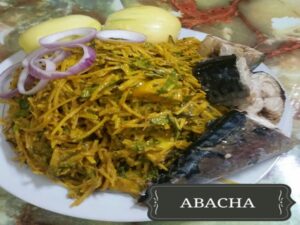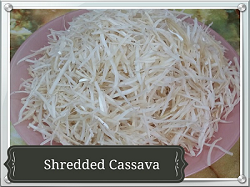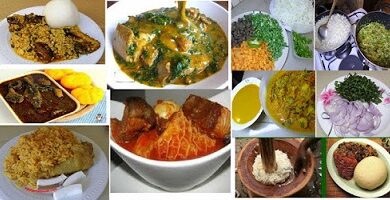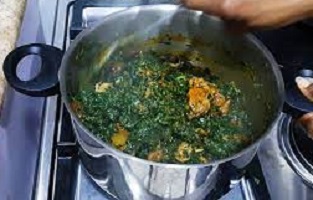Abacha and Ugba: African Salad Recipe
Abacha and Ugba: African Salad Recipe
Abacha and Ugba, popularly known as African Salad, is a traditional Nigerian dish made from cassava flakes (Abacha) and fermented oil bean seeds (Ugba), mixed with palm oil, spices, and seasonings.
This savory delicacy is often garnished with garden eggs, Utazi leaves, and fish, making it a flavorful and satisfying meal or snack.

Abacha and Ugba
My grandmother always said Abacha isn’t a full meal. While it can be just as filling as a main dish, African Salad is traditionally enjoyed as a snack or light meal between meals.
How to Make Abacha with Ugba
Abacha
I fondly recall my grandma making Abacha after returning from the Eke or Afor market.
She would garnish it with garden eggs, their leaves, and some dry fish. Those long vacations at her place hold unforgettable memories.
Abacha is made from cassava tubers, which are first cooked until tender. Then, they are sliced with a special grater, soaked in cold water overnight, thoroughly washed, and finally sun-dried.
The Role of Ugba (Ukpaka)
A must-have for African Salad, Ugba is made from oil bean seeds.
These seeds are cooked for several hours, sliced, washed, and allowed to ferment slightly, adding a rich, distinct flavor to the dish.
Ingredients for African Salad
To create a delicious African Salad, you’ll need the following ingredients.
While some ingredients may not be readily available depending on your location, the more you add, the tastier your dish will become!
Basic Ingredients
First, gather the essentials:
- 3 handfuls of Abacha (cassava flakes)
- 2 cups Ugba (Ukpaka)
- 30 cl red palm oil
- 2 tablespoons powdered potash (food tenderizer)
- Fish: Mackerel, dry fish, or stockfish
- 1 large onion
- Salt and dry pepper (to taste)
- 4 tablespoons ground crayfish
- 2 stock cubes (Maggi/Knorr)
- 1 teaspoon ground Ehu seeds (Calabash Nutmeg)
Optional Seasoning
If you want to take the flavor up a notch, you can also add:
- 1 teaspoon Ogiri/Iru (traditional Nigerian seasoning)
Other Ingredients
For added texture and flavor, you can include the following:
- 3 fresh Utazi leaves (Gongronema latifolium)
- Ponmo/Kanda (cow skin)
- Garden eggs (as much as desired)
- Garden egg leaves (1 medium bunch)
- 1 medium onion (sliced for serving)

Preparation Steps
- Prepare the Ingredients
To begin, roast, peel, and grind the Ehu seeds. Then, cook the Ponmo until tender and cut it into small pieces. Depending on the type of fish you are using, fry or roast the mackerel, soak the stockfish in water, and debone the dry fish. Next, wash and chop the vegetables. Slice one onion finely, and cut another into rings for garnish. Wash the garden eggs (there’s no need to cut them), and grind the crayfish and pepper. Afterward, soak the Abacha in cold water to soften it and rinse the Ugba with lukewarm water. Once softened, drain the Abacha. Finally, dissolve the powdered potash in one cup of cold water and set it aside. - Prepare the Palm Oil Base
Now, pour the palm oil into a pot. Add the liquid from the potash mixture, making sure to avoid the sediments. Stir the mixture thoroughly until the palm oil turns into a yellow paste. - Incorporate the Seasoning
Next, add the ground pepper, ground Ehu, crushed stock cubes, crayfish, diced onions, and Ugba. Stir everything together to ensure the ingredients are even. - Add Flavor Enhancers
Afterward, mix in the Ogiri/Iru and Ponmo. Stir thoroughly to combine the flavors. - Combine with Abacha
At this point, add the soaked and drained Abacha. Mix everything well so that the Abacha fully has the palm oil paste on its body. - Add Utazi and Salt
Then, slice the Utazi leaves and mix them in. Be sure to adjust the salt to taste, but remember that after adding all the seasonings, you may not need much salt. - Heat (Optional)
If you prefer your Abacha warm, transfer it to the stove and heat it on medium until it reaches your desired temperature. Once heated, turn off the stove and stir in the sliced garden egg leaves. - Serve
Finally, serve your African Salad either warm or cold, garnished with garden eggs, fish, and onion rings. To complete the experience, enjoy it with a glass of chilled palm wine.
Final Notes
Watch the video below for a demonstration of how I prepare mine. While I used minimal ingredients in the video, feel free to experiment with the full list for a richer, tastier dish!




Pingback: Palm Wine Elixir: Nature’s Gift of Culture, Healing & Celebration - 9jafoods